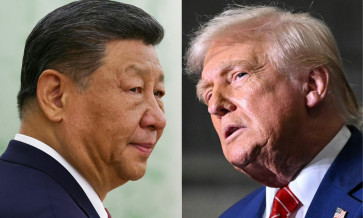Popular Reads
Top Results
Can't find what you're looking for?
View all search resultsPopular Reads
Top Results
Can't find what you're looking for?
View all search resultsHistoric images from The Hermitage
Amid today’s hectic pace, reflections on past struggles and achievements may offer rare moments of appreciation for things taken for granted, yet so specific and critical
Change text size
Gift Premium Articles
to Anyone
A
mid today’s hectic pace, reflections on past struggles and achievements may offer rare moments of appreciation for things taken for granted, yet so specific and critical.
Farm-woman, by Pablo Picasso.
This is what made the exhibition “Matisse to Malevitch, Pioneers of Modern Art from the Hermitage”, and its accompanying catalog edited by Albert Kostenevich compelling. It unfurled the shaping of the new. A fascinating experience.
Displayed with the stories behind their creation, the 75 works, which were brought to Amsterdam from the display at the State Hermitage in St. Petersburg, Russia, formed an interesting lesson in courage and creative innovation, not only from the artists, but also from their collectors.
The largest number of works originate from Henri Matisse (born in 1869), an artist who convinced Russian collector Sergey Ivanovich Shchukin that buying his works was visionary despite it going against the grain.
At that time, Matisse was a dominating force in the group of artists who had moved away from the traditional canons of art and instead indulged in the exaltation of pure color. They caused a scandal in the Salon d’Automne (Autumn Salon) — a Parisian artist salon — in 1905.
The critic Louis Vauxcelles had dubbed them the Fauves, or Wild Beasts.
But Segey Ivanovich Shchukin, who belonged to an old merchant family and headed a Russian textile company, didn’t mind. He often used to visit Paris, and loved the contemplative as well as the excitement evoked in painterly surfaces of Matisse’s oeuvre. The group around Matisse were looking to liberate themselves from the nature theme and from academic traditions in painting. He saw they were the leaders of the future, and they proved him right.
They formed the first important avant-garde movement of the 20th century, which arose in French painting around 1900 in reaction to Impressionism and Pointillism. Bright and contrasting colors, rough brushwork, simplified forms and bold distortions characterized the new art.
Shchukin’s acquisitions are said to be the most daring of the early 20th century. He had 37 paintings from Matisse alone, some of these are in the current exhibition of The Hermitage, and have rarely been seen before.
This is also true for Abramovich Morozov, another Russian collector, though to a much lesser extent
than Shchukin. The two were considered eccentric in Russian society at that time.
Visitors to Shchukin’s house where he exhibited the works, made fun of him. But the works from France offered new perspectives to the young Russian artists, who also frequented the collector’s house.
Matisse did not only use bright and joyous colors, but also thick contours to accentuate his figures, as can be seen in A Game of Bowls featuring three almost stiff figures against a peculiar green.
A Game of Bowls, by Henri Matisse.
The artist changed his canvas The Red Room, which was originally painted blue, to dark red, after a mood swing. Surprisingly, Shchukin, who had wanted the painting to be blue, had no objections to the new color. He even liked it.
Shchukin’s collection in The Hermitage also included Picasso’s works.
It is said the collector was not initially attracted to Picasso, but eventually became addicted and purchased even more works than he did from Matisse.
Three grand Pablo Picasso paintings dominate the main hall of the exhibit, including the daunting Dryad, Femme Assise and the Femme à l’Éventail, all referring to beauty and sexuality, although a few paintings of dumb looking farm women can also be seen. Shchukin who initially was not attracted to Picasso ended up collecting 54 of his paintings.
Works from other painters also feature in the exhibition, such as André Derain, Louis Vlatat, Henri Manguin, Raoul Dufy Maurice de Vlaminck, Kees van Dongen, Auguste Chabaud, Albert Marquet, Charles Guérin, Chaim Soutine.
But it is really Kadinsky that strikes a chord for me, with landscapes through which lines flow like musical compositions.
And last but not least, Malevich’ Black Square, a pitch black geometrical plane encompassing everything — nature, life, and being.
— Photos from Matisse to Male-vich, Pioneers of Modern Art from the Hermitage catalog
Matisse to Malevich: Pioneers of Modern Art from the Hermitage
March 6- September 17, 2010
Amstel 51, Amsterdam
Ph +31 (0)20 530 74 88











